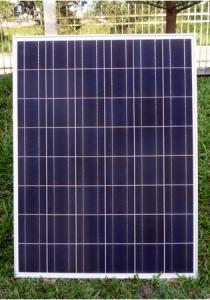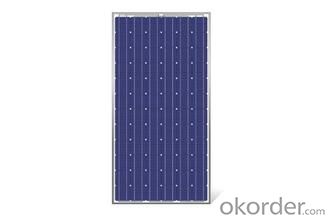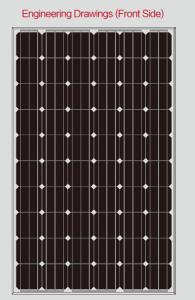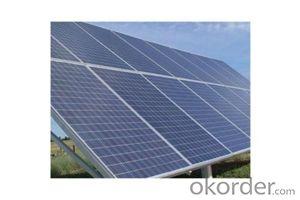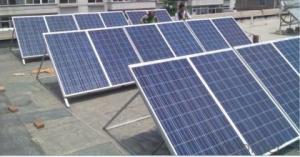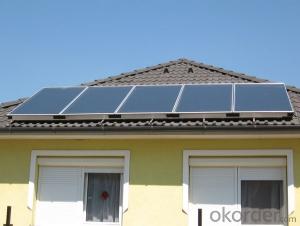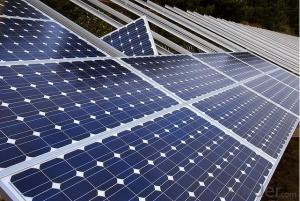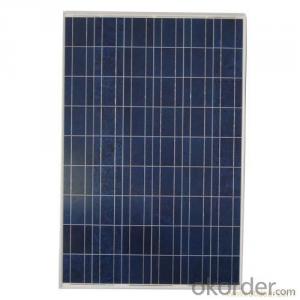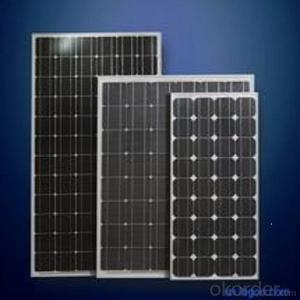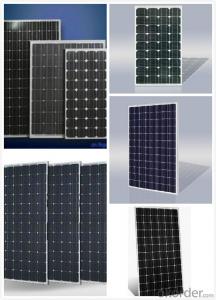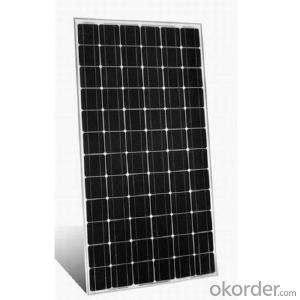Solar Panels on Rooftop:Solar Power Module with Low Factory Price CE TUV UL Certificate
- Loading Port:
- Shanghai
- Payment Terms:
- TT OR LC
- Min Order Qty:
- 200 watt
- Supply Capability:
- 50000 watt/month
OKorder Service Pledge
OKorder Financial Service
You Might Also Like
Introduction
195W Solar Photovoltaic Panel with low factory price,this is a kit using for factory and storge field. this product is a higer output version with stable power and we gurantee you for 15 years.
company introduction
National Building Materials Group Corporation (CNBM) was established in 1984 with approval from the State Council, and then became a Central Enterprise under direct supervision of State-owned Assets Supervision and Administration Commission of the State Council in 2003.
Upholding the philosophy of “Making Best Use of Resources to Serve Construction”, and vigorously carrying out such strategies as “technical innovation”, “internationalization of building materials”, and “building strength with talents”, CNBM is the largest comprehensive building materials industry group in China that integrates scientific research, manufacturing and logistics into one entity, and consists of four business platforms, i.e. industry, technology, complete set of equipment, and trading & logistics. As of the end of 2009, CNBM’s total assets exceeded RMB 110 billion, with 100,000 employees, and 20 companies under direct management with 100% share control or majority control, among which 6 were listed companies, including 2 overseas listed.
CNBM practices the parent-subsidiary management system, and is one of those wholly state-owned enterprises carrying out the pilot trial of Board of Directors system and innovation system. As the strategic center, decision center, resources center, and policy & culture center, our Group exercises its right as a contributor. Whereas, our sub-groups functioning as business platforms, are mandated to construct the profit center based on their core competences to enlarge brand awareness and increase market share.
suggestied application
home lighting business lighting,
Garden lighting, pavement lighting
Farmer household lighting
Decorative water pump
Traffic signal lighting
industry area
business area
Integrated into panel array for solar power system from 500W onward.
Product features
180W~200W output under standard conditions
Output Voltage 24V,Serial connection of 3 units is suitable for 48V power system
Poly-crystallize Solar Cells from Taiwan or Germany
Product life over 15 years
Resistance to fluctuations of temperature, humidity and strong wind
Manufactured under IEC61215 Solar Photovoltaic Panel requirements
packing
Individual carton box for solar panel
2 solar modules in a carton
A carton board separates two solar panel
For LCL goods, we use bulk carton box or wooden boxes
Parameters
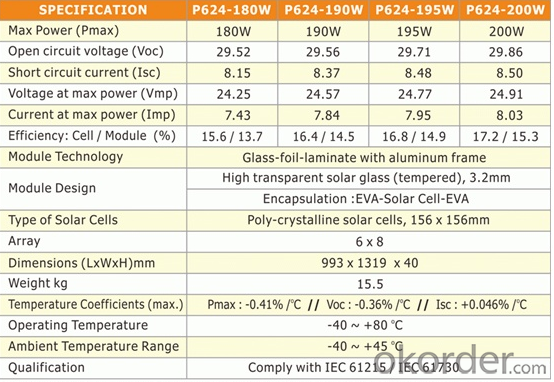
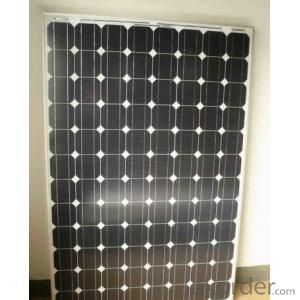
- Q: I need to power a series of meraki wireless repeaters that plug into a standerd wall outlet. consuming 5v or .08 amps However I need this in a remote location (like out in the middle of nowhere) Using A solar panel as power supply and a battery to store the energy but, how and what do I use to convert the energy coming from the solar panel to the battery and the batteries power supply to match the needs of the meraki wireless repeater? How do I make this as compact as possible? Do I need a ac/dc converter? or dc/ac converter? Any suggestions or solutions would be great !
- First things first. 5 Volts @ .08 amps would be .2 Watts. therefore you would need at least the same amount from a solar panel to replenish the batteries. But what puzzles me is the notion that plugging it in a wall outlet ? If you use 20 V @ 0.08 then the power consumption is 9.6 Watts And what is a meraki wireless repeater? I never heard of one. I'm a FCC licensed Ham and have some idea what is available. If you need 5 volts DC, you could use twelve Ni-cads in series and just keep them trickle charged with the solar panel That would make it compact. If you were to use an automotive battery (or motorcycle), then you would need a DC/DC converter.
- Q: i was looking into making solar panels to reduce my electric bill, but i need to know how to actually hook it up.
- nowing what to do with unused renewable electricity is always a dilemma – hooking up to the grid has to be the preferred option. If your residential home is grid tied, i.e. connected the electricity grid as opposed to off-grid and you are using solar panels to generate electricity. Then it makes a lot of sense to hook your solar panels to the grid, because instead of losing the unused electricity or having to maintain a bank of deep cycle batteries, you simply feed it back to the grid. You feed electricity back to the grid via your electric meter which measures the electricity in Kilowatt per hour. This has the effect of reversing your meter which in turn reduces your electricity bills and if you are generating a lot of electricity you could find the utility company owing you money! The Solar Powered System Therefore, your solar powered installation would look like this. The solar panel will connect to an “array disconnect” – you need an array disconnect for system maintenance because it allows you to easily shut off the power. The array disconnect is connected to an “inverter”. The solar panel generates DC power and the electricity from the grid is AC power. Therefore, you need an inverter to convert DC power to AC power. The inverter is connected to an “AC breaker panel”. This is the interface where your solar generated electricity meets the electric meter and allows you to feed electricity back to the grid. Now in most countries and states you are not allowed to tamper with the electric meter so at this point you should contact your local electricity energy supplier and ask them to supply an engineer to hook you up to the grid. If you have anything to add to this article or you have connected your system to the grid – tell us how you did it by writing a comment below.
- Q: What materials are solar panels made of?
- Solar panels are typically made of photovoltaic (PV) cells, which are primarily composed of silicon, along with other materials such as metal frames, glass, and encapsulation materials.
- Q: How do solar panels affect the property's community image?
- Solar panels can positively impact a property's community image by showcasing the owner's commitment to sustainability and environmental responsibility. Their presence can inspire others to adopt renewable energy solutions, leading to a more eco-conscious community perception. Additionally, solar panels can enhance the property's aesthetic appeal, especially when integrated seamlessly into the design.
- Q: will at least consider them for their home electricity? I've seen several articles that new technologies are now being used, but it doesn't seem to be promoted to residential apps. I've even seen that the solar technology will be used in paints in the near future.
- As the cost of fossil fuels continues to rise, solar panels become of more value. At one time they were looked on as a rather expensive investment with only a long-term pay off. Now oil is so expensive other sources of power such as wind, solar panels and geothermal energy become relatively cheaper. The efficiency of solar panels is expected to rise so that even in regions where sunlight is limited, these become a realistic investment.
- Q: They have been around long enough to be cheaper. Unless they are made out of a natural material that is rare and hard to find, there is no reason why they should be so expensive. On another note, I think that all low power devices like cell phones and even laptops should have solar panels. Even if it is not enough to fully power the device for a long period of time, it will provide some electricity savings and with millions of people saving a little power adds up.
- Photo okorder /... Notice it costs over $200 and it takes up a sizable amount of space. Plus you have to expose it to bright sun light. Over all this is not something the average consumer wants to spend money on or fuss with. If something is expensive, difficult or inconvenient to use then people won't use it. Just the basic economics of such a device limits its sales never mind its functionality and usability. Even if you made a small one buit into the cover to extend the battery you won't get much of an extension and you will increase the cost of your laptop. Consider how people shop, will they buy the more expensive laptop for a questionable amount of battery extension? Mass production can lower costs but in order to mass produce something you need a demand that will consume what you produce. But if no one wants the item because of the aforementioned issues than you can't justify mass producing the item. This is like the classic which came first Chicken or Egg problem, one doesn't happen without the other. Cost reduction doesn't happen without consumer demand. This is where tax incentives, subsidies, low cost loans and energy buyback contracts come into play in order to spur on demand and jump start mass production. You could also make electricity extremely expensive by taxing oil and carbon so that a Solar Cell becomes economically competitive to very expensive electricity. Problem with this option is the negative impact high energy costs have on economic activity. Just look at what happened a couple of summers ago when gas hit $4/gal. To spur on demand we need to incentives the use of Solar cells (and other alternative energy). This can be done through several means such as subsidies, tax incentives, low interest loans, energy buyback contracts etc...
- Q: Can solar panels be used to power a swimming pool?
- Yes, solar panels can be used to power a swimming pool. Solar panels can generate electricity from sunlight, which can be used to power pool pumps, heaters, and other equipment required for pool maintenance and operation.
- Q: Can solar panels be installed on public transportation systems?
- Yes, solar panels can be installed on public transportation systems, such as buses and trains, to harness solar energy and reduce their reliance on traditional energy sources. This can help to make public transportation more sustainable and environmentally friendly.
- Q: Can solar panels be used in multi-story buildings?
- Yes, solar panels can be used in multi-story buildings. They can be installed on the rooftops or facades of these buildings to harness solar energy and generate electricity. Additionally, advancements in solar panel technology have made it possible to integrate them into building materials, such as windows or cladding, allowing for even more flexibility in their use in multi-story structures.
- Q: Can solar panels be used for charging laptops or smartphones?
- Yes, solar panels can be used for charging laptops or smartphones. Portable solar panels, such as those designed for outdoor activities or camping, are available in the market. These panels can convert sunlight into electricity and charge your devices through USB ports or power banks. Additionally, some laptops or smartphones also have the capability to directly charge from solar panels using special adapters or cables.
Send your message to us
Solar Panels on Rooftop:Solar Power Module with Low Factory Price CE TUV UL Certificate
- Loading Port:
- Shanghai
- Payment Terms:
- TT OR LC
- Min Order Qty:
- 200 watt
- Supply Capability:
- 50000 watt/month
OKorder Service Pledge
OKorder Financial Service
Similar products
Hot products
Hot Searches
Related keywords
